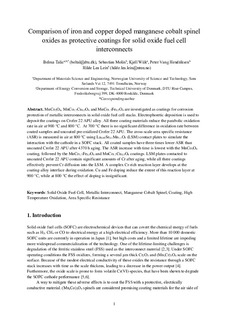| dc.contributor.author | Talic, Belma | |
| dc.contributor.author | Molin, Sebastian | |
| dc.contributor.author | Wiik, Kjell | |
| dc.contributor.author | Hendriksen, Peter Vang | |
| dc.contributor.author | Lein, Hilde Lea | |
| dc.date.accessioned | 2018-01-19T11:21:19Z | |
| dc.date.available | 2018-01-19T11:21:19Z | |
| dc.date.created | 2017-12-14T09:10:38Z | |
| dc.date.issued | 2017 | |
| dc.identifier.citation | Journal of Power Sources. 2017, 372 145-156. | nb_NO |
| dc.identifier.issn | 0378-7753 | |
| dc.identifier.uri | http://hdl.handle.net/11250/2478339 | |
| dc.description.abstract | MnCo2O4, MnCo1.7Cu0.3O4 and MnCo1.7Fe0.3O4 are investigated as coatings for corrosion protection of metallic interconnects in solid oxide fuel cell stacks. Electrophoretic deposition is used to deposit the coatings on Crofer 22 APU alloy. All three coating materials reduce the parabolic oxidation rate in air at 900 °C and 800 °C. At 700 °C there is no significant difference in oxidation rate between coated samples and uncoated pre-oxidized Crofer 22 APU. The cross-scale area specific resistance (ASR) is measured in air at 800 °C using La0.85Sr0.1Mn1.1O3 (LSM) contact plates to simulate the interaction with the cathode in a SOFC stack. All coated samples have three times lower ASR than uncoated Crofer 22 APU after 4370 h aging. The ASR increase with time is lowest with the MnCo2O4 coating, followed by the MnCo1.7Fe0.3O4 and MnCo1.7Cu0.3O4 coatings. LSM plates contacted to uncoated Crofer 22 APU contain significant amounts of Cr after aging, while all three coatings effectively prevent Cr diffusion into the LSM. A complex Cr-rich reaction layer develops at the coating-alloy interface during oxidation. Cu and Fe doping reduce the extent of this reaction layer at 900 °C, while at 800 °C the effect of doping is insignificant. | nb_NO |
| dc.language.iso | eng | nb_NO |
| dc.publisher | Elsevier | nb_NO |
| dc.rights | Attribution-NonCommercial-NoDerivatives 4.0 Internasjonal | * |
| dc.rights.uri | http://creativecommons.org/licenses/by-nc-nd/4.0/deed.no | * |
| dc.title | Comparison of iron and copper doped manganese cobalt spinel oxides as protective coatings for solid oxide fuel cell interconnects | nb_NO |
| dc.type | Journal article | nb_NO |
| dc.type | Peer reviewed | nb_NO |
| dc.description.version | acceptedVersion | nb_NO |
| dc.source.pagenumber | 145-156 | nb_NO |
| dc.source.volume | 372 | nb_NO |
| dc.source.journal | Journal of Power Sources | nb_NO |
| dc.identifier.doi | 10.1016/j.jpowsour.2017.10.060 | |
| dc.identifier.cristin | 1527097 | |
| dc.description.localcode | © 2017. This is the authors’ accepted and refereed manuscript to the article. Locked until 5.11.2019 due to copyright restrictions. This manuscript version is made available under the CC-BY-NC-ND 4.0 license http://creativecommons.org/licenses/by-nc-nd/4.0/ | nb_NO |
| cristin.unitcode | 194,66,35,0 | |
| cristin.unitname | Institutt for materialteknologi | |
| cristin.ispublished | true | |
| cristin.fulltext | postprint | |
| cristin.qualitycode | 1 | |

